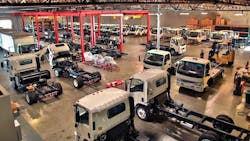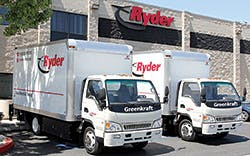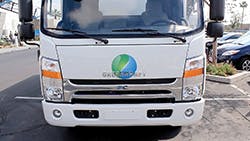Craft beers seem to be the rage as beer connoisseurs seek just the right taste for their palettes.
Greenkraft sees itself in somewhat the same way—a small, custom truck manufacturer that provides customers with a taste that is difficult to find anywhere else. But the company has a somewhat higher calling—to help make the planet a healthier place to live.
“We build trucks that are powered by CNG, LPG, gasoline and hybrid electric,” says George Gemayel, president of Greenkraft Inc in Santa Ana, California. “Diesel is a carcinogen. But we want to provide an option. We are here to offer a cleaner way to fuel a medium-duty truck.”
Greenkraft manufactures Class 4-7 trucks with a choice of gasoline, propane, compressed natural gas, or hybrid electric power. The company’s most popular models are low-cab-forward trucks.
Chassis cab components are sourced from JAC Motors, an automobile and truck manufacturer in China.
“Only about 20% of the content of our trucks come from China,” Gemayel says. “Even the instrumentation of the cab is made here. It’s our design and produced for us by and outside vendor.”
The heart of the Greenkraft trucks are also sourced domestically. Typically the trucks are powered by a GM engine that run on alternative fuels. It is coupled with GM or Allison automatic transmission. Driveshaft and axle also are domestically sourced.
Greenkraft Inc was established in 2008. The company’s truck lineup includes Classes 4-7. All of this will take place in a newly acquired 150,000-sq-ft plant that the company took over in January. The new location in a Santa Ana industrial park, is three times the size of Greenkraft’s previous facility, near current Greenkraft headquarters. The new facility will include several overhead cranes, assembly lines and an expanded parts division.
The larger quarters will enable the company to accommodate an expanding product line. Greenkraft is adding Class 6 and Class 7 models—labeled the G3 and G4—with GVW ratings of 26,000 and 33,000 pounds.
“This expansion is to fulfill demand on both current models and the new ones,” Gemayel says.
How it works
Greenkraft will combine production, engineering, and testing in the 150,000-sq-ft location. Greenkraft has engineers on staff. They are responsible for design, powertrain integration, plus some contract engineering.
Greenkraft has a strategic partner—California Environmental Engineering (CEE, LLC)—that certifies that the vehicles meet federal emission regulations as well as those of the California Air Resources Board.
Emissions testing is performed by CEE, LLC in a dedicated room filled with a dynamometer and other equipment to record and analyze the performance of each truck.
Located near the Port of Long Beach, Greenkraft logs in the imported chassis and stocks them in one bay that runs the length of the building. The adjacent bay is used for assembly and installation of components.
Greenkraft’s three major product lines are trucks, conversion systems, and engines. Truck production is growing rapidly, the company says.
Conversion systems are quickly becoming a major revenue source for Greenkraft. The company can take various existing truck models that run on gasoline fuel and convert it to run on CNG or LPG.
The third product line that is contributing to GKIT’s revenue increase are engines for repowering trucks with different fuel options, and engines for agriculture equipment and stationary machines used in various industries with different fuel options.
Greenkraft sells its products nationally. The company has customers in New York, New Jersey, and Ohio, but marketing is concentrated on the West Coast.
“Our customers include large and small private fleets, along with municipalities and other government entities,” Gemayel says. “We are concentrating on green states, and states that are offering incentives,”
Most of the products Greenkraft produces are eligible for various incentives ranging from $6,500 to $95,000 per truck. The largest incentives are for CNG and hybrid electric vehicles. The company partners with Efficient Drivetrains Inc of Northern California to produce its hybrid electric trucks.
Greenkraft has a dealer network of six companies but plans to expand that number to 25 by the end of 2017.
“Greenkraft is going to revolutionize the trucking industry with the introduction of these new 26,000 and 33,000 lbs. trucks that run on CNG and PROPANE fuel,” Gemayel says. “The only way we can meet the increased demand for Greenkraft products is to expand our current factory. This expansion is one of many factors that will substantially increase the company’s revenue in 2017.” ♦
More on Greenkraft at greenkraftinc.com
About the Author
Bruce Sauer
Editor
Bruce Sauer has been writing about the truck trailer, truck body and truck equipment industries since joining Trailer/Body Builders as an associate editor in 1974. During his career at Trailer/Body Builders, he has served as the magazine's managing editor and executive editor before being named editor of the magazine in 1999. He holds a Bachelor of Journalism degree from the University of Texas at Austin.



